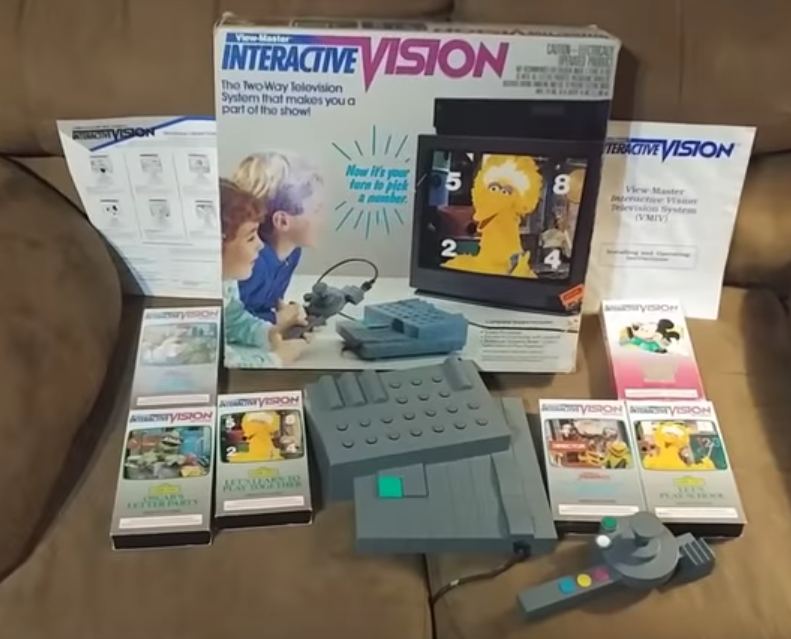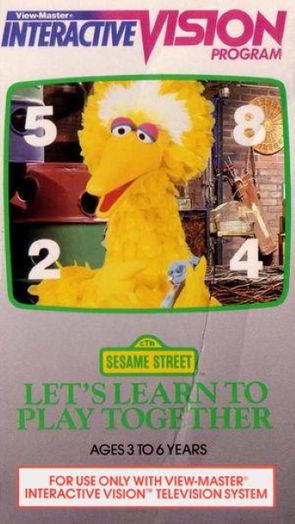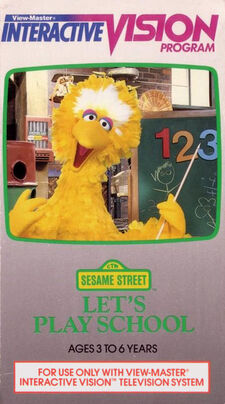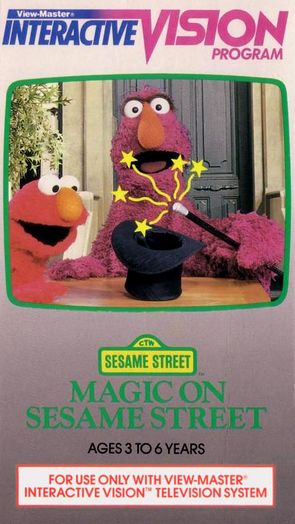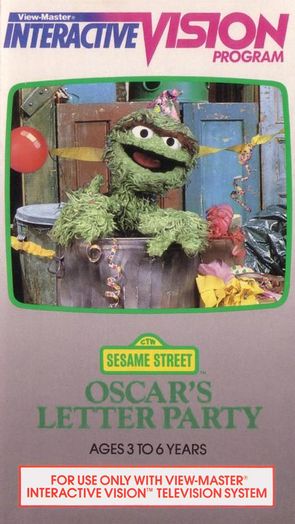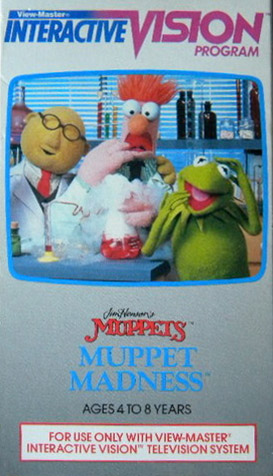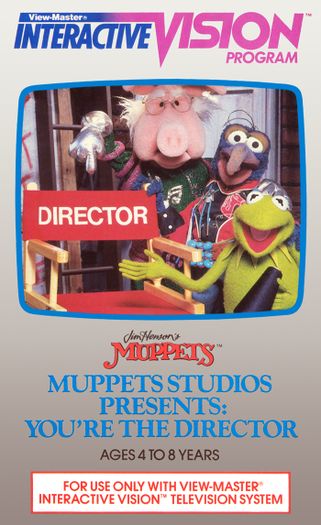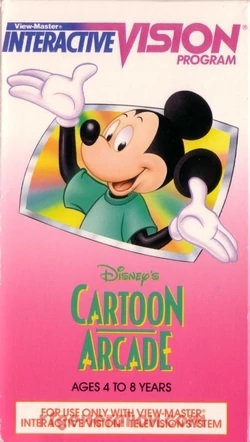View-Master Interactive Vision (found VHS-based games; 1988): Difference between revisions
No edit summary |
|||
| Line 64: | Line 64: | ||
|Muppet Studios Presents: You're the Director | |Muppet Studios Presents: You're the Director | ||
|[https://archive.org/details/graphics-muppet-madness-youre-the-director<span style="color:green;">'''Found'''] | |[https://archive.org/details/graphics-muppet-madness-youre-the-director<span style="color:green;">'''Found'''] | ||
|[https://archive.org/details/graphics-muppet-madness-youre-the-director<span style="color: | |[https://archive.org/details/graphics-muppet-madness-youre-the-director<span style="color:green;">'''Found'''] | ||
|Some alternate graphics and audio are not in this copy but are in the ZC_Infinity Youtube capture (and tygerbug restoration). | |Some alternate graphics and audio are not in this copy but are in the ZC_Infinity Youtube capture (and tygerbug restoration). | ||
|- | |- | ||
| Line 72: | Line 72: | ||
|Restored version. | |Restored version. | ||
|} | |} | ||
==Gallery== | ==Gallery== | ||
{{Video|perrow =2 | {{Video|perrow =2 | ||
Revision as of 16:07, 9 February 2024
The View-Master Interactive Vision was a children's VHS-based game console released in 1988. The console was produced by View-Master Ideal Group, Inc. The company is most well-known for its View-Master film-slide viewer toys. In a message that was printed on all of the View-Master Interactive Vision boxes, View-Master Ideal Group Inc. president Arnold Thaler explained the philosophy behind the product. He viewed the system as a "two-way learning and entertainment television system," as the characters on screen would often address the user directly, and their interactions would change depending on the user's choices. He was particularly fond of the console's ability to remember the choices that had been made, allowing for a recap or final score to be provided to the user.[1]
In the end, only seven tapes were released for the system. Four tapes were taken from Sesame Street. They used a mixture of newly recorded footage, which often explained how to use the console, as well as Sesame Street stock footage that was used as a backdrop for games. Two tapes were taken from Jim Henson's Muppets, and they used entirely original scenarios built around giving the player the View-Master Interactive Vision controller to control the outcome of the story. The last tape, Disney Cartoon Arcade used footage from classic Disney cartoons as a sort of framing device for simple arcade games.
Basic Operation
The console used special VHS tapes to supply full-motion video for the games. These were chosen so that the console could be attached to the family VCR, which was a common household item at the time. The video and audio from the VHS tapes were passed through the console en route to the television. The system used gen-lock technology to generate moving graphics on top of the full-motion video, merge the video streams together and output the video to the television. In addition to the full-motion video, the tapes contain hidden data in the overscan of the video frame, which the console is able to interpret.[2]
If a tape is played directly from a VCR to a television without the console, the user will see a barcode moving up the right-hand side of the screen. This contains the information that the console needs to generate the moving graphics and switch to an alternate audio track. The left side of the video frame contains a moving audio waveform. Essentially, the designers wanted to have a separate audio track to allow the characters to respond differently depending on the user's actions. However, many VCRs at the time were only capable of mono audio output, so it was not as simple as switching the console to only output the left or right audio channel from the tape. Instead, they hid the second audio track inside the video stream, and the console is able to pull the data out and swap between outputting the regular audio and the hidden audio based on the programming data.
VHS is a linear format, and the console had no ability to control the tape transport. This alternate audio track allowed them to have the user's actions seem to control the outcome. Often, the characters' lip-syncing would be carefully timed so that it looked natural with either audio track. Other times, a split-screen would be used in which the FMV showed both outcomes. However, one of the outcomes would be covered up by graphics depending on which track was being played. In the ending of Disney's Cartoon Arcade, failing the final game resulted in a full-screen FMV sequence being completely covered up by graphics and muted, as it was only shown as a reward for success.
Capture and Preservation
As of late 2023, the VHS tapes have been captured in at least three different ways, and are about as well preserved as a VHS tape possibly could be. This is no longer lost media. Working together, Garrett Gilchrist (tygerbug) has posted MiniDV captures and video restorations to Archive, Zachary Christensen (zcinfinity) has posted gameplay footage to Youtube, and Andrew York (titan91) and Tony Anderson have posted RF captures to Archive, which can be decoded using vhs-decode, a fork of the Domesday Decoder project. Gameplay is not emulated but the audio and binary data is readable, and it would be a stretch to consider this Lost Media. The optical audio and binary data can be read from these VHS captures in some form.
On Feb 8 2024, Garrett Gilchrist posted the first of his restored edits to Archive, Disney's Cartoon Arcade, which was presented in its original edit and in a version with higher quality footage inserted of the Disney cartoon clips. There has also been some deconstruction of the View-Master console hardware, in an attempt to eventually bring it to MAME. Restored edits of the other six tapes (by Gilchrist) are basically complete (but need rendering into web formats) and are expected by March 2024.
Given the complexity of the tapes, there is a large amount of data that must be captured in order to fully preserve a tape. First, the tape should be captured directly from a VCR to preserve the original hidden audio waveform and programming barcode. While the console does not currently have an emulator, the raw footage will be useful for future emulator development, as the emulator will need to be able to interpret the hidden data. For this same reason, the hidden data should be captured at the highest quality possible. However, the output of the console with the rendered graphics should also be captured in good quality so that the graphics themselves are available for reference. This will require multiple capture sources for some scenes, as user choice will sometimes result in entirely different graphics being rendered. Finally, all of the audio from both the regular and alternate track should be captured, which will also require multiple captures.
It is possible to decode the onscreen audio from an interlaced capture of the VHS, using AEO-Light, but this provides low quality results compared to the console's own output. The restorations by Garrett Gilchrist will use a mixture of both methods.
The console's instruction manual explains how to hook up the console to the VCR and television. The VCR's RF output, composite video output, and mono audio output must be connected to the console. It is not entirely understood why all three connections are required, as an RF signal for televisions contains both the audio and video in a single cable. The console itself only has an RF output, while most digitizers require composite video and separate audio. Therefore, the signal should be demodulated, either through a second VCR or another piece of equipment capable of performing this task. Once we have this signal, we will need to add extra steps in order to get the signal into our digitizer, rather than a television.[3]
In order to capture either raw video footage or video with rendered graphics, the VCR must be connected to a capture device that can handle the video signal. The data in the over-scan is often rejected by the capture device, resulting in a "No Signal" error. It has been shown that sending the signal through a composite-to-HDMI video upscaler and then into an HDMI capture device can work to capture the signal. This works both for direct capture from the VCR and from the console. However, the top of the video frame folds down on top of itself, the frame is generally unstable, and the video drops so many frames that the audio and video end up out of sync. The only saving grace of this method is that the alternate audio track is maintained properly, with only a slight hum when the alternate track switches in. This light hum may have occurred on televisions of the time as well, due to the unusual audio delivery. An alternate method has been discovered using a higher-end VCR that had extra circuitry for video stabilization. This was able to stop the frame from folding down on itself and stabilized the image. At this point, the composite video, whether taken directly from the VCR or routed through the console, worked correctly with a composite-to-USB digitizer. However, this video stabilization broke the alternate audio track, which became heavily distorted by a loud buzz.
Preservation Status
| Title | Status of Raw Video and Main Audio | Status of Rendered Graphics and Alt Audio | Notes on Missing Material |
|---|---|---|---|
| Sesame Street: Let's Learn to Play Together | Found | Found | Forgetful Jones remembering his number during the Greeblies sequence is not present here, but will be in the tygerbug version. |
| Sesame Street: Magic on Sesame Street | Found | Found | The alternate audio and graphics from the "voice changing" and "storytelling" sequences do not appear here, but are in the ZCInfinity version. Alternate Spanish audio for "Sing" will be in the tygerbug restoration (previously omitted for copyright). |
| Sesame Street: Let's Play School | Found | Found | See also: the ZCInfinity Youtube capture. |
| Sesame Street: Oscar's Letter Party | Found | Found | Alternate graphics and audio are not accounted for here, but are in the ZCInfinity capture. Oscar's comments during the alphabet animation will be in the tygerbug version. |
| Muppet Madness | Found | Found | Some alternate graphics and audio are not in this copy but are in the ZCInfinity capture (and tygerbug restoration). |
| Muppet Studios Presents: You're the Director | Found | Found | Some alternate graphics and audio are not in this copy but are in the ZC_Infinity Youtube capture (and tygerbug restoration). |
| Disney's Cartoon Arcade | Found | Found | Restored version. |
Gallery
References
- ↑ The message from View-Master Ideal Group president Arnold Thaler, taken from the back of the console box. Retrieved 17 May '20
- ↑ Online unofficial FAQ explaining how the VMIV console works. Retrieved 17 May '20
- ↑ The instruction manual which explains the hook-up process for the console. Retrieved 17 May '20
